January 04, 2009
Not Just Decietful...Risky
Over at Information Dissemination, Galrahn is tilting at the windmill of misleading nomenclature. It seems that some in the USN are determined to have everyone believe hat the Littoral Combat Ship...that 3,000 ton speedboat with the armament of a Coast Guard cutter...the one that is intended to act as a tender in time of war...is a Frigate.
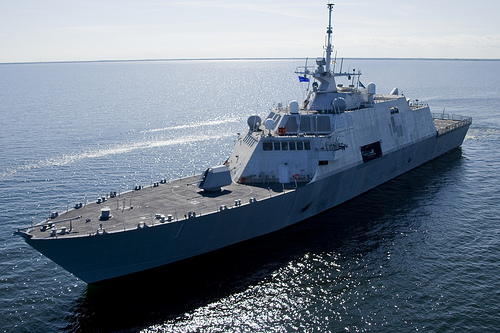
Take it away Galrhan...
The last sentence might seem an over the top reaction to what seems to a layman a simple bureaucratic nomenclature fight. However it is entirely correct when one is aware of the history and implications of misrating warships.
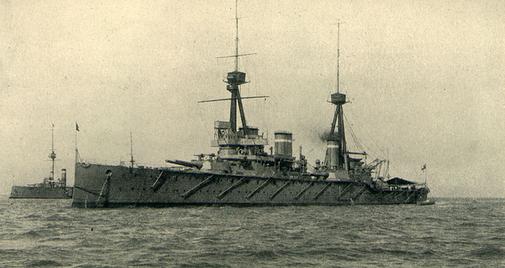
HMS Invincible...the first battle cruiser.
Although not entirely applicable to this problem the story of the UK's battlecruisers is illustrative. In the early 1900's the UK built a series of big, very fast cruisers with battleship caliber guns intended to scout ahead of the battleline and overwhelm more conventional cruisers and commerce raiders. They were armored like the preceding armored cruiser classes and had cruiser strength scantlings. The big guns were intended to outrange other cruisers and provide a means to fire back on scouting duties while they hightailed it from the sort of close combat they were not intended to meet. For domestic political reasons, they were, around 1911, designated BATTLE cruisers and the term "capital ship" was coined to give the impression that they were part of the battle fleet...thereby giving the impression to the public that the Royal Navy had more battleships than it really did. During WW1 they were thrown into the battle line at Jutland so their heavy cannons would not "go to waste"...with the result that 3 were sunk in quick succession with the loss of all but 30 of 3300 crew between them.
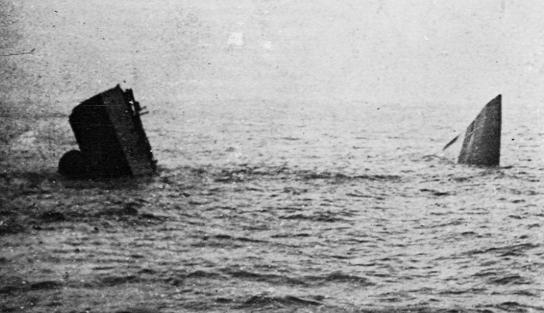
HMS Invincible...a double tombstone for over a thousand men.
Like the battlecruisers, the Littoral Combat ship is built to less stringent structural standards than other frontline ships, and like them it seems to be a very expensive solution to the problem it is intended to tackle.
However, it gets worse than that, because there is a major difference between the two types of ship.
Battlecruisers carried big guns and could (and did) damage the enemy. Invincibles career was quite distinguished right up to her loss. HMS Renown and Japans (British designed) BC's gave a good account of themselves in the second world war. Although vulnerable to fire, they packed a punch (Churchill called them "...eggshells armed with hammers"). The LCS has a 57mm gun, some machine guns and, if the NLOS missile is not cancelled, some light guided artilery rockets (NLOS is basically a long range Hellfire). The remote vehicles it is supposed to carry have no ship killing weapon. Its most powerful ordinance will be carried by its 2 helicopters. It is potentially a very useful support vessel and can complement the capabilities of frontline ships, but it is fragile and can't fight. In a hot war LCS is an eggshell armed with toothpicks and a multi-tool, fighting a bowling ball.
Galrhan is right, the vessel is certainly not a frigate. And this is an important distinction for reasons beyond it's vulnerability. Unlike the Battlecruisers, which brought battleship guns to the table, the LCS brings basically nothing to the frontline at all save an additional target (and a fragile one at that) Because of its lack of any serious weapons, no admiral is going to be inclined to use it as a combat asset because it can't add anything except perhaps electronic warfare capability. No, the danger for the navy is that CONGRESS decides that these vessels represent actual warships and orders them IN LIEU of more warships....which might leave an admiral with nothing else to send.
To a congresscritter, especially the sort of congresscritters we have in the majority now, calling the LCS a "frigate" is the same as saying its a destroyer escort. To them this makes requests for actual warships redundant. They would rather spend money on almost anything else and this nomenclature gambit gives them an out.
This is not to say the vessel is worthless necessarily....
It's capabilities are indeed useful and are well in line with a gunboat or "peace cruiser".
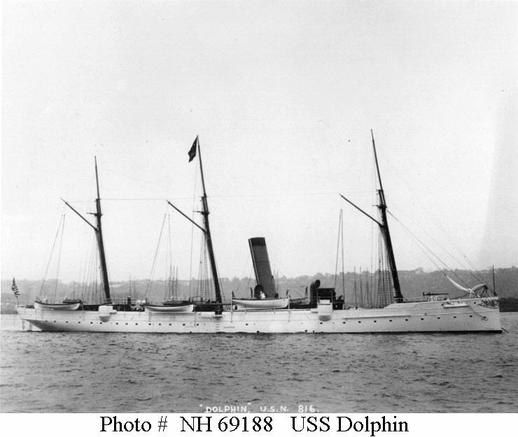
It has a modest armament geared to policing duties and the capacity to carry additional equipment. In the 19th century the additional equipment consisted mainly of marines and perhaps relief supplies, this ship can carry those and more.
While the USN's naming scheme for capital ships is haywire at the moment, it is clear from the naming convention announced for the the LCS (they are named after small towns...just like most of the old PGs and peace cruisers) that the Navy considers them basically Patrol Gunboats in function.
With their huge flex decks an impressive helicopter decks, these vessels can do the soft power activities like disaster relief and possibly even low end hospital ship missions and such. Like the old gunboats these could be useful auxiliaries in a hot war, being used as ROV support and mine countermeasures ships much as the old gunboats tended to be used as tenders and minesweepers....the big difference is that that capability is built into them from the start.
If there is a gripe about the LCS aside from those trying to classify it as a frigate, it is that they seem to be a very expensive solution to the problem. Better, more robust and versatile results might be obtained with an actual frigate but with a flex deck, something superficially along the lines of Denmarks Absalon class but with 4 rather than 2 diesels, a modest number of missile tubes and a full fire-control system. Such a vessel would be more expensive than HDMSAbsalon, but not much more expensive than a regular frigate would be because all that would be added would be steel....which is cheap in comparison to electronics.
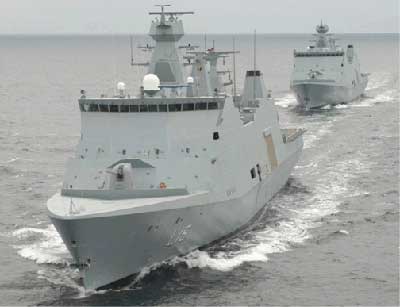
Note that HDMSAbsalon, while very austere, has, with her 5" gun, 36 ESSMs, 16 harpoons and 6 TTs, a somewhat greater punch than the Perry class frigates as built, and is in a whole different league from the LCS.
Such a vessel would broach some criticism as it would draw more water, but Absalon for instance carries 2 CB90s which can carry the fight into far shallower water than LCS (and with, say 2 NLOS packs could have almost the same armament).
For a variety of reasons put forth here I feel that most of the peacetime things that can be done adequately by a warship armed like the LCS can be more efficiently done by the US Coast Guard..however the cutters aren't going to have the support capability for minesweeping and such that the LCS designs do.
Now, it may be that the 50 kts speed and other less visible characteristics mean that one of the Litorral Combat ship designs is better suited to the subsidiary duties it is intended to do, but these duties don't include going into harms way and these vessels are not frigates by any measure. Referring to these interesting vessels as such officially threatens to displace real warships which the navy needs in addition to auxiliaries.

Words like warship and frigate matter, when the LCS is sold as a frigate or as a warship, it carries with the name an expectation the ship is best used as a warship or frigate. The LCS is neither best used or even well used as either. A modern warship that does not carry a single kill weapon of any kind is not a warship, and if the ship is intended to be used in theaters of war then it does so only as a support ship when it brings no offensive tactical capabilities during wartime. The function of the LCS is support, the tactical principles are exclusive to roles of scouting and C2, by every tactical metric as constructed and in CONOP when explained, the LCS is a support ship, not a warship. The intent to explain, describe, or sell the LCS as a warship is dangerous, dishonest, and deceitful.
The last sentence might seem an over the top reaction to what seems to a layman a simple bureaucratic nomenclature fight. However it is entirely correct when one is aware of the history and implications of misrating warships.

Although not entirely applicable to this problem the story of the UK's battlecruisers is illustrative. In the early 1900's the UK built a series of big, very fast cruisers with battleship caliber guns intended to scout ahead of the battleline and overwhelm more conventional cruisers and commerce raiders. They were armored like the preceding armored cruiser classes and had cruiser strength scantlings. The big guns were intended to outrange other cruisers and provide a means to fire back on scouting duties while they hightailed it from the sort of close combat they were not intended to meet. For domestic political reasons, they were, around 1911, designated BATTLE cruisers and the term "capital ship" was coined to give the impression that they were part of the battle fleet...thereby giving the impression to the public that the Royal Navy had more battleships than it really did. During WW1 they were thrown into the battle line at Jutland so their heavy cannons would not "go to waste"...with the result that 3 were sunk in quick succession with the loss of all but 30 of 3300 crew between them.

Like the battlecruisers, the Littoral Combat ship is built to less stringent structural standards than other frontline ships, and like them it seems to be a very expensive solution to the problem it is intended to tackle.
However, it gets worse than that, because there is a major difference between the two types of ship.
Battlecruisers carried big guns and could (and did) damage the enemy. Invincibles career was quite distinguished right up to her loss. HMS Renown and Japans (British designed) BC's gave a good account of themselves in the second world war. Although vulnerable to fire, they packed a punch (Churchill called them "...eggshells armed with hammers"). The LCS has a 57mm gun, some machine guns and, if the NLOS missile is not cancelled, some light guided artilery rockets (NLOS is basically a long range Hellfire). The remote vehicles it is supposed to carry have no ship killing weapon. Its most powerful ordinance will be carried by its 2 helicopters. It is potentially a very useful support vessel and can complement the capabilities of frontline ships, but it is fragile and can't fight. In a hot war LCS is an eggshell armed with toothpicks and a multi-tool, fighting a bowling ball.
Galrhan is right, the vessel is certainly not a frigate. And this is an important distinction for reasons beyond it's vulnerability. Unlike the Battlecruisers, which brought battleship guns to the table, the LCS brings basically nothing to the frontline at all save an additional target (and a fragile one at that) Because of its lack of any serious weapons, no admiral is going to be inclined to use it as a combat asset because it can't add anything except perhaps electronic warfare capability. No, the danger for the navy is that CONGRESS decides that these vessels represent actual warships and orders them IN LIEU of more warships....which might leave an admiral with nothing else to send.
To a congresscritter, especially the sort of congresscritters we have in the majority now, calling the LCS a "frigate" is the same as saying its a destroyer escort. To them this makes requests for actual warships redundant. They would rather spend money on almost anything else and this nomenclature gambit gives them an out.
This is not to say the vessel is worthless necessarily....
It's capabilities are indeed useful and are well in line with a gunboat or "peace cruiser".

While the USN's naming scheme for capital ships is haywire at the moment, it is clear from the naming convention announced for the the LCS (they are named after small towns...just like most of the old PGs and peace cruisers) that the Navy considers them basically Patrol Gunboats in function.
With their huge flex decks an impressive helicopter decks, these vessels can do the soft power activities like disaster relief and possibly even low end hospital ship missions and such. Like the old gunboats these could be useful auxiliaries in a hot war, being used as ROV support and mine countermeasures ships much as the old gunboats tended to be used as tenders and minesweepers....the big difference is that that capability is built into them from the start.
If there is a gripe about the LCS aside from those trying to classify it as a frigate, it is that they seem to be a very expensive solution to the problem. Better, more robust and versatile results might be obtained with an actual frigate but with a flex deck, something superficially along the lines of Denmarks Absalon class but with 4 rather than 2 diesels, a modest number of missile tubes and a full fire-control system. Such a vessel would be more expensive than HDMSAbsalon, but not much more expensive than a regular frigate would be because all that would be added would be steel....which is cheap in comparison to electronics.

Such a vessel would broach some criticism as it would draw more water, but Absalon for instance carries 2 CB90s which can carry the fight into far shallower water than LCS (and with, say 2 NLOS packs could have almost the same armament).
For a variety of reasons put forth here I feel that most of the peacetime things that can be done adequately by a warship armed like the LCS can be more efficiently done by the US Coast Guard..however the cutters aren't going to have the support capability for minesweeping and such that the LCS designs do.
Now, it may be that the 50 kts speed and other less visible characteristics mean that one of the Litorral Combat ship designs is better suited to the subsidiary duties it is intended to do, but these duties don't include going into harms way and these vessels are not frigates by any measure. Referring to these interesting vessels as such officially threatens to displace real warships which the navy needs in addition to auxiliaries.
Posted by: The Brickmuppet at
12:56 AM
| Comments (4)
| Add Comment
Post contains 1341 words, total size 10 kb.
<< Page 1 of 1 >>
32kb generated in CPU 0.0849, elapsed 0.1333 seconds.
68 queries taking 0.1225 seconds, 182 records returned.
Powered by Minx 1.1.6c-pink.
68 queries taking 0.1225 seconds, 182 records returned.
Powered by Minx 1.1.6c-pink.









